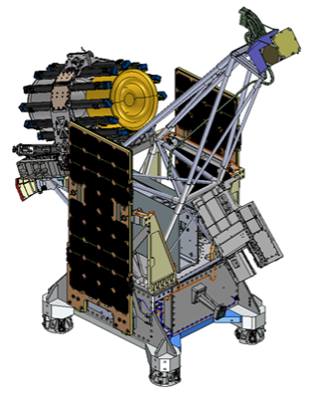Small Spacecraft Activities Around the Agency
Highlights from NASA’s small spacecraft activities are profiled quarterly. Links for more information are provided.
Highlights for December 2023
NASA’s Ames Research Center
NASA’s Starling spacecraft are getting in formation: the mission team has spent the last two months troubleshooting issues and commissioning the four spacecraft, nicknamed Blinky, Pinky, Inky, and Clyde.
Pinky, Inky, and Clyde have successfully completed their propulsion system commissioning and have executed maneuvers to get into their swarm operations configuration, maintaining a range between 50-200 km apart. The three have also successfully demonstrated two-way communications with their crosslink radios in this closer proximity.
After launch, ground operators noticed a propulsion system leak on Blinky which caused the spacecraft to enter a slightly lower orbit. The issue was resolved, but it resulted in the spacecraft moving far in front of the others. To correct this, the other three spacecraft performed maneuvers to catch up to Blinky and the swarm is now reunited. The Starling team continues to test Blinky’s propulsion system while the spacecraft is in swarm position.
Testing and commissioning the spacecraft is an important step in preparing for swarm experiment operations, as well as understanding what challenges future spacecraft swarms might experience. The next mission phase will be focused on development and testing of key swarm technologies.
NASA’s Goddard Space Flight Center / Wallops Flight Facility
The Pandora mission held its critical design review (CDR) in October and mission engineers will being working with NASA’s Launch Services Program (LSP) on obtaining a rideshare. Pandora is an ESPA-class SmallSat mission from Goddard Space Flight Center (GSFC) led by Principal Investigator Dr. Elisa Quintana that will survey transiting exoplanets orbiting nearby stars with photometric and spectroscopic observations. Pandora will identify benchmark planets that are ideally suited for more in-depth atmospheric studies by James Webb Space Telescope and for future larger missions that will remotely search for signs of life in exoplanet atmospheres. Pandora is funded by the NASA Science Mission Directorate (SMD) Astrophysics division through the Pioneers program and is in collaboration with Lawrence Livermore National Laboratory, NASA Ames Research Center, and a host of other institutions for science contributions.
https://smallsat.wff.nasa.gov/missions/pandora.php
https://pandora.gsfc.nasa.gov/
Two NASA GSFC CubeSats, BurstCube and SigNals of Opportunity: P-band Investigation (SNOOPI), are on track for December 14, 2023 deliveries to NanoRacks for an International Space Station (ISS) launch in March 2024.
BurstCube is a 6U CubeSat mission led by Dr. Jeremy Perkins that aims to improve rapid alerts and detection of gamma-ray burst events by characterizing short gamma-ray bursts. It is funded by the NASA Science Mission Directorate Astrophysics Division. It is a collaboration amongst several institutions including the University of Alabama, University of Maryland, University of the Virgin Islands, Universities Space Research Association, Naval Research Lab, and NASA Marshall Space Flight Center.
https://smallsat.wff.nasa.gov/missions/burstcube.php
https://heasarc.gsfc.nasa.gov/docs/heasarc/missions/burstcube.html
SigNals of Opportunity: P-band Investigation (SNOOPI) is a 6U CubeSat mission led by Principal Investigator Dr. James Garrison that will be the first on-orbit demonstration of the P-band (240-380 MHz). SNOOPI will use this new antenna to measure vegetative soil moisture and snow water from space. Vegetative soil moisture is of national importance and critical to food production and observations in the P-band frequency are required to analyze the root zone. SNOOPI is funded by the NASA Earth Science Technology Office and in collaboration with Purdue University, Mississippi State University, NASA Goddard Space Flight Center, United States Department of Agriculture, and NASA Jet Propulsion Laboratory.
https://smallsat.wff.nasa.gov/missions/snoopi.php
https://esto.nasa.gov/invest/snoopi/
NASA’s Jet Propulsion Laboratory
Several small spacecraft projects recently completed milestones.
The Investigation of Convective Updrafts (INCUS) project completed the project preliminary design review successfully on September 20 and 21, 2023 at NASA’s Jet Propulsion Laboratory. The observatory configuration is shown in Figure 1. The spacecraft critical design review is scheduled for December 2023.
Sun Radio Interferometer Space Experiment (SunRISE) completed assembly and test of all six space vehicles. Launch is expected in late 2024 or early 2025. SunRISE is an array of six toaster-size CubeSats that will work together to study solar activity. The mission will observe low radio frequency emissions so scientists can understand better how the Sun is able to generate intense space weather storms – known as solar particle storms – that can be hazardous to spacecraft and astronauts. This research will help scientists forecast space weather, improve our understanding of how our Sun works, and may apply to studies of other stars – particularly those with planets.
Polar Radiant Energy in the Far InfraRed Experiment (PREFIRE) will help close the gap in understanding the loss of heat from Earth to cold space to better inform climate and ice models. One of the two CubeSats, is named “Nanuq”, the Inuktitut word for polar bear. The other is named “Tuktu”, which means caribou. The two sun-synchronous 525 km orbits have been determined (MLTAN 04:00 and 0:800) to optimize sampling over the polar regions, while keeping the CubeSats continuously charged. The science data pipeline is in place, with most algorithm testing complete. The project operational readiness review / mission readiness review is planned for January 31, 2024. Launches have been awarded to Rocket Lab USA, which will provide two dedicated Electron launches from Mahia, New Zealand in May 2024.



























